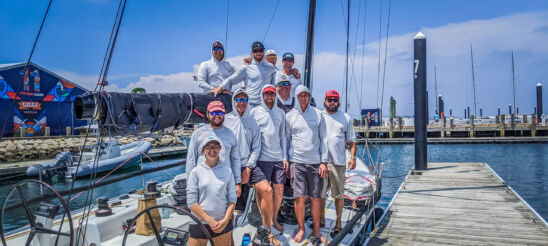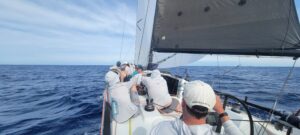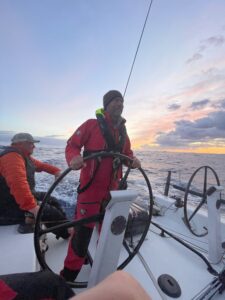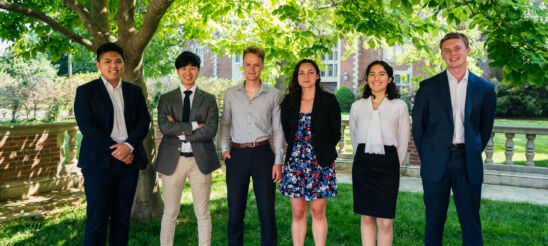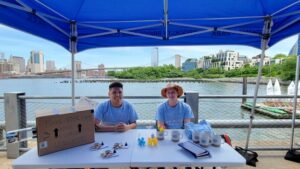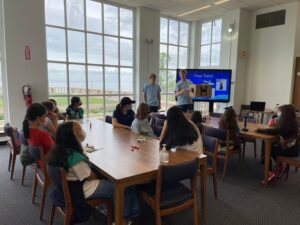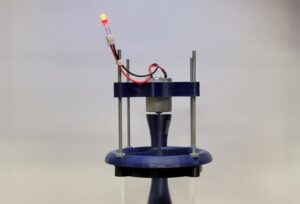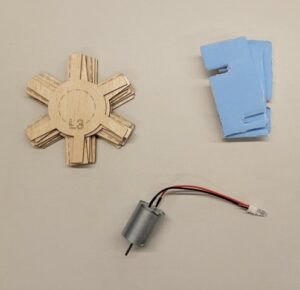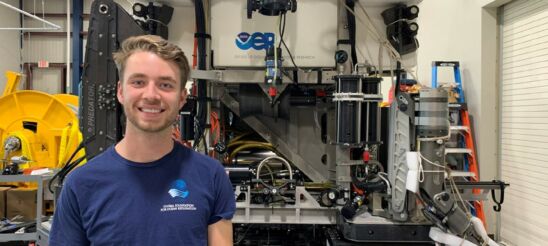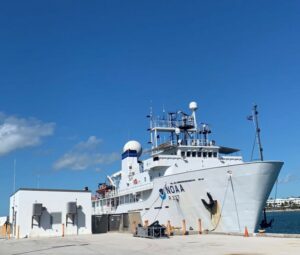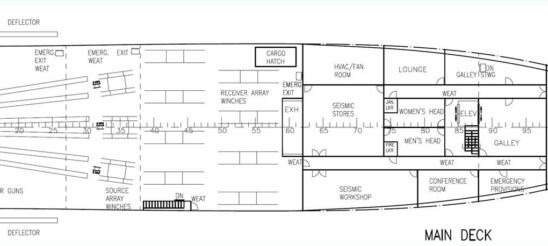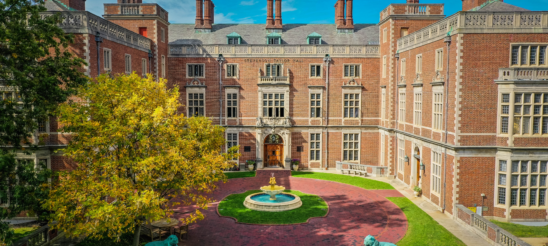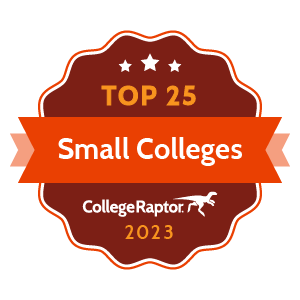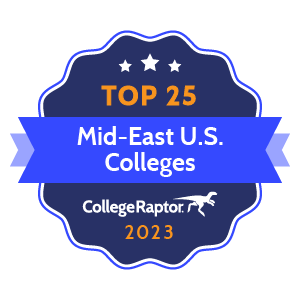The Newport Bermuda Race
Aboard the Desperado by Abner Mills ’24
My Experience on Desperado for the Newport to Bermuda Race was very different from Zach’s on Groupe 5. We sailed with 12 people with a set of 3 watch groups and a Navigator that was separate from the watch system.
On a distance race like N2B, it’s very common that you will spend time in every role at one point or another. I am usually a bowman, and I very much did take part in the majority of the sail changes but I also spent a lot of time trimming sails and driving the boat. The first day of the race was miserable weather, it was very lumpy seas and loads of rain which tested my stomach for sure. The following day leading up to the gulf stream had high winds and decent waves for surfing. We were seeing boat speeds in the high teens very often and I believe our max boat speed was 23kts. We had to gybe out before the gulf stream to avoid the adverse current but after a few hours, we were heading to Bermuda again.
On the morning of our last day, the breeze started to die down and the rest of our race was a bit slower. We finally got in after an elapsed time of 73 hours 51 minutes and 22 seconds. Zach may have a better telling of the conditions than I, he is better at remembering those details, also they were in relatively close proximity for a good majority of the race.
We ended up coming 2nd in the Gibbs Hill Professional Division and 1st in Class 18 for this Race, quite the showing for a student-filled boat.
Sailing Background
• Offshore Team Co-Captain along with Zach Doerr.
• I first learned to sail by taking the small boat sailing merit badge at boy scout summer camp.
• In order to continue sailing and learn more, I found a group called the Cayuga Lake Cruising Fleet. I would have to travel an hour and a half one way to be able to sail every weekend. I sailed a Tanzer 25 usually in a mixed fleet of around 5 to 8 other boats. My boat did okay usually.
• Since starting at Webb I have logged over 3500nm.
• Most of my Webb sailing has been on Figaro 2’s with my 2nd semester of sophomore year including much more sailing on Desperado for races such as Vineyard (Fall semester), AYC Spring Race Series, EDLU, Block Island Race, Newport – Bermuda Race.
• Over the summer between freshman and sophomore year, I stayed on campus with a few others and raced in the Block Island Race Week, Around Long Island Race, and many other races on the Long Island Sound.
Aboard the Figaro 2 by Zachary Doerr ’24
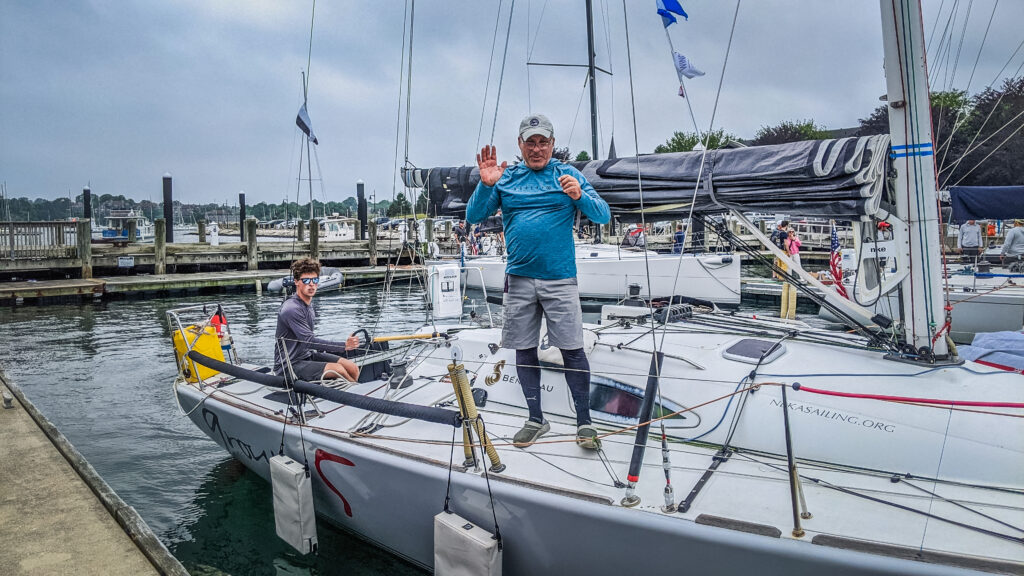
I sailed on a modified Figaro 2 in the Double Handed Division with my coach Vlad Shablinsky. The start for us was amazing conditions. We had a small upwind portion while leaving Newport before it became a tight jib reach in around 18-20 knots of wind from the southwest.
Within two or three hours, however, the wind shut off. At this point, we had fairly large leftover swells making the boat quite miserable to be on. These conditions lasted the rest of the first day. We did a lot of sail changes in the light and fluky conditions as a cold front passed over us.
After the front passed in the middle of the first night, the wind began to fill in beautifully from the northwest at 20 knots. We put up our running spinnaker, which we carried for the rest of the race. The waves built and there was a lot of good surfing opportunities. The top boat speeds going down waves was typically 16-20 knots, with a top speed for the race of 21 knots. Throughout the second day, it increased in strength as we approached the Gulf Stream. At the Gulf Stream, we gybed into a southeast moving eddy and stayed with it for most of the second night. We had some serious squalls with winds into the low 30 knot range. We carried our big spinnaker the entire time, and Vlad and I both worked hard that night to keep the boat upright.
As morning approached, the wind steadied at around 25 knots, and after exiting the Gulf Stream we gybed onto starboard tack again, and decided to sail low, keeping east of the Rhumb line. As the third day went on, the wind began to shift right and eventually to slowly die during the third night. We were lifted nicely to Bermuda and had to throw in just a few gybes within sight of the island. We finished on our fourth day at sea in about 10-12 knots of wind with an elapsed time of 77 hours, 41 minutes, and 22 seconds. We ended up correcting five hours ahead of our nearest competitor in the double handed division and nearly eleven hours ahead of the next boat in our class, taking first place in both class and division.
Sailing Background
• Offshore Team Co-Captain along with Abner Mills
• From Butler, PA
• Learned to sail first on my dad’s Capri 22, he sold that and bought a Cal 24 which I continued to learn on. I then started sailing sunfish and eventually Hobie 16s as well. I also had some experience with J80s and Flying Scots before Webb. Most sailing was done on a small lake in PA with a little bit of Great Lakes sailing and Chesapeake Bay sailing as well.
• I have done several regattas on the Figaro 2s, and have done Around Long Island Race 2021, Vineyard Race 2021, Block Island Race 2022, Newport Bermuda Race 2022, and Bermuda Short Handed Return 2022 on Groupe 5.
• Like AJ, I also stayed on campus last summer.
Webbies Win U.S. Department of Energy’s Marine Energy Collegiate Competition
by Juliette Lehman ’22
Webb Institute was a first time competitor in the U.S. Department of Energy’s Marine Energy Collegiate Competition (MECC), which is hosted by the National Renewable Energy Laboratory (NREL). The MECC requires participating teams to complete a technical design, business plan, and financial analysis of a particular marine energy solution. Teams are also required to participate in various forms of community outreach to increase understanding and interest of marine energy.
The Webb MECC team also completed the optional Build and Test portion of the competition. The team was comprised of seven students: Juliette Lehman ’22, Sasha Kritsuk ’22, Luke Kiely ’22, Minh Tran ’22, Adriana Torres-Rodriguez ’23, Si Cong Chen ’23, and Rebecca Ashmore ’25, and was advised
by Professors Michael Martin and Richard Royce.
The team submitted their report, “An Oscillating Water Column Wave Energy Converter for Small-Scale Disaster Relief” along with a poster and presentation of the research. This research was then presented to a panel of industry professionals.
The Build and Test portion of the project was taken from Juliette Lehman ’22 and Sasha Kritsuk’s ’22 thesis, The Design, Construction, and Testing of an Oscillating Water Column Wave Energy Converter. Financial analyses were performed based on Luke Kiely’s ’22 thesis, A Feasibility Study of the Installation and Operation of a Floating Offshore Windfarm in the United States. The focus of the technical design was to create a simple, cost-effective oscillating water column that could generate enough power to operate an ambulatory health-care facility and desalination plant. The business plan targeted areas that are particularly susceptible to frequent natural disasters.
For its community engagement, the Webb team worked hard to create educational materials and kits for young students, host and attend community events, and interact with industry professionals. Professor Bradley Golden connected the team with the Girl Scouts of America, who visited Webb to learn about wave energy and build their own model oscillating water column! The team also attended the Brooklyn Boatworks Launch Day, where students also built and interacted with their own wave energy converters. Adriana Torres-Rodriguez ’23 and Si Cong Chen ’23 attended Water Power Week to gain an understanding of the elements important to creating a business model for wave energy converters.
The team was excited to receive awards for both Best Outreach and Community Engagement and First Place Overall. While the team was thrilled to perform so well in its first year of competing, there was also much to learn from this first year. This competition not only provided resources and funding for research but was also a wonderful opportunity for Webb Institute to form an inter-class team of students. This year’s team is excited to hear that another Webb team has been approved for next year’s competition and we wish them the best of luck!
More information about the team can be found on webbmecc.wordpress.com!
Winter Work Term: More than a Robotics Company
by Jonathan Alenn ’23
I’m sure you’ve heard the phrase “Good things come to those who wait”. When finding winter work spots, I wouldn’t recommend it, but I got lucky for my junior year internship. I still did not have a job lined up in early December when Professor Golden sent out an email saying an underwater robotics company was looking for two interns. A cover letter, interview, and acceptance letter in a couple days and I had booked my ticket for the sunny shores of central Rhode Island. Three months later and I had completed my favorite internship on the chilly shores of Key West.
The Global Foundation for Ocean Exploration (GFOE) is more than just a robotics company. They design, build, maintain, and operate some of the most sophisticated remotely operated vehicles (ROVs) in the world. They run expeditions across the seven seas searching for some of the world’s most isolated plants, animals, and shipwrecks. Capable of going 6000 meters deep, almost four miles, deep, GFOE has explored areas such as the Hawaiian Islands, Mid-Atlantic Ridge, and Marianas Trench.
I did my internship with Evan Spalding, a sophomore who, like me, absolutely loves to ski. We went skiing several times in Vermont and his home “mountain” of Yawgoo on a powder day. I also took trips to Newport, Maine, and Boston. Weekends were always fun to explore the Northeast in the winter for a Florida man.
I worked at GFOE’s main workshop in Quonset, Rhode Island for seven weeks. While there, I got to go hands-on almost every single day with their two largest ROVs, Deep Discoverer (D2) and Seirios. From the first day, they had Evan and I working on the different systems. The first week we completely took apart and reassembled the rock boxes and drawers on D2. After that, I worked on the hydraulics system, tracing out the different components and adjusting the manifold settings so the speeds were correct. Then using Solidworks I made from scratch an adapter piece for the new PDM cable on D2 that was put out for order a week later. One of my favorite things was to restore an old mini-sub that used to dive in Narragansett Bay. It will now be on display at the Mystic Seaport Museum. These are just a few of the things they had Evan and I doing, and we never found ourselves without meaningful and interesting work.
The highlight of the internship; however, had to be my 10 days going from Pascagoula to Key West on a “shakedown cruise” aboard NOAA’s Okeanos Explorer. All of the mission systems on board were rigorously tested to get ready for their spring and summer expeditions. I shadowed all the different team members from the deck hands, navigator, co-pilots, and winch team. I quickly fell into a pattern on board and enjoyed life on the water.
I liked it so much, I went back. This summer I was part of their expedition to the Azores Islands off the coast of Portugal for 28 days. I’m especially thankful to Professor Golden for connecting to me to this great company filled with awesome people. Even if I had to wait for it.
SD1 Projects: Porpoise
Designers: Jack Kirk, Kira Shaw, Cole Matthes, Deck Uttmark
Vessel Type: Seismic Survey Vessel
Vessel Mission: The primary objective of the Porpoise is to investigate the formation of rocks, oceanographic trenches, and other subsea geology that could affect the lives of humans and the marine environment through seismic survey.
Technical Specifications:
LOA: 84.7m
LWL: 80.7m
Beam: 18m
Design Draft: 6.5m
Depth: 18.3m
Design Speed: 12kts
Survey Speed: 4.5kts
Capacity: 40 people
Endurance: 60 days, 8,000 nm
Service life: 30 years
80MT Bollard Pull
View Presentation
Visit our Junior Class Small Vessel Design Project page to view all of this year’s projects.
About Junior Class Small Vessel Design Project (SD1):
As a part of Professor Bradley D.M. Golden’s ’99 Ship Design 1 (SD1) class, the juniors spent the first two-and-a-half months of the spring semester preparing their first complete concept designs.
Using the knowledge they’ve gained in their nearly three years studying at Webb and the experiences from their winter work periods to date, this was the students’ first opportunity to apply the naval architecture and marine engineering principles they’ve studied including stability, ship’s structures, main machinery systems, auxiliary systems, resistance and propulsion, and electrical engineering.
Working in small groups of three and four, the students selected one of the vessel types and took their first couple of spins around the design spiral to prepare vessel concept designs. To help make the project as realistic as possible, members of industry familiar with each of the vessel types helped prepare the statements of design requirements that each of the designs had to meet. To challenge the students even further, one or two “curveballs” were thrown into each design statement to make the students think long and hard about how they would achieve their objectives.
At the end of the spring semester, the students presented their final designs to their fellow students, faculty, and members of industry who served as part of an evaluation team. After three years at Webb, the Junior class can now say with confidence that they’re familiar with the design process and are well on their way to joining the fields of naval architecture and marine engineering.
Webb Institute Named a 2023 Best College by College Raptor
Webb Institute has been selected as a 2023 Best College in the U.S. by College Raptor, a leading college planning platform that helps families discover college matches driven by AI algorithms to find the best colleges at the best price.
Webb Institute was ranked:
#20 in Top 25 Best Small Colleges
#23 in Top 25 Best Mid-East Colleges
This selection recognizes Webb Institute as a leading institution in the country based on a combination of factors including the school’s graduation rates, campus diversity, endowment per student, and other key metrics as reported via the National Center for Education Statistics (NCES) for the most recently available enrollment year.
“Since 2015, we’ve carefully assembled our lists each year to highlight the best schools in different categories to help families get started in the discovery process,” said Bill Staib, College Raptor’s CEO. “Webb has shown dedication to academic excellence. We are proud to highlight them.”
College Raptor’s full methodology is outlined here.
About College Raptor, Inc.
College Raptor® is the most evolved, accurate, and comprehensive college search site with tools to empower students, parents, counselors, and colleges with college planning. College Raptor is the only college search platform that enables students and families to discover quality, affordable college options based on personalized estimates of financial aid, scholarships, academic match, and acceptance odds at every 4-year college in the country. More than 25 million students and families have used College Raptor to find cost-effective, academically appropriate college options that prepare them for future careers. For more information, visit CollegeRaptor.com.

